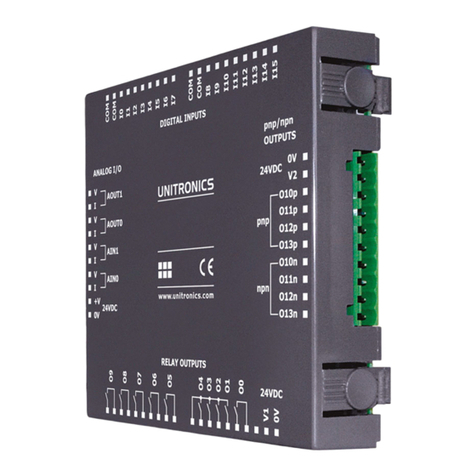
Function description of the module
8111_en_05 PHOENIX CONTACT 17 / 54
Monitoring by hardware
The encoders are usually monitored by hardware. The hardware monitors the encoder
supply, detects open circuits, and faulty electrical signals with symmetrical encoders.
An error is indicated by:
– The red “Encoder error (03/07)” LED of the channel is ON.
– The red “I/O error (E)” LED of the module is ON.
– The EncSurvINCx bit of the channel is set.
– Diagnostic message to the controller (8600hex; see Section “Diagnostic state (0018hex:
DiagState)” on page 32).
2.5.4 Referencing
In order to have a defined reference value for position detection, it is possible to set a
reference point. The parameterized reference value is entered as a position value in the IN
process data at this point. The value range for the reference point is 0000 0000hex to
FFFF FFFFhex. For each channel there is one input for connecting a reference switch (Ref1,
Ref2) available in order to determine the reference point.
You can set the reference point in the engineering tool or in object 0080hex as follows:
Table 2-4 Referencing functions
Function Meaning Example
Direct setting of the reference
point
In this mode, the reference point is set immediately in the process data by
the corresponding bit (StateRefINx). The only condition for the direct setting
is that the drive is at rest at the reference position.
Referencing to the rising edge
of the reference signal in the
positive direction of motion
The reference value is taken over as position value, when a rising edge has
been detected at the reference input and the direction of motion is positive.
Figure 2-4
Referencing to the falling edge
of the reference signal in the
positive direction of motion
The reference value is taken over as position value, when a falling edge has
been detected at the reference input and the direction of motion is positive.
Referencing to the rising edge
of the reference signal in the
negative direction of motion
The reference value is taken over as position value, when a rising edge has
been detected at the reference input and the direction of motion is negative.
Referencing to the falling edge
of the reference signal in the
negative direction of motion
The reference value is taken over as position value, when a falling edge has
been detected at the reference input and the direction of motion is negative.
Referencing to the rising edge
of the reference signal in the
positive direction of motion
with Z
The reference point is set on the rising edge of the Z signal, after the rising
edge of the reference point signal has been detected and the direction of
motion is positive.
You can specify an offset for detecting a Z signal (see below).
Figure 2-5
Figure 2-6
Referencing to the falling edge
of the reference signal in the
positive direction of motion
with Z
The reference point is set on the rising edge of the Z signal, after the falling
edge of the reference point signal has been detected and the direction of
motion is positive.
You can specify an offset for detecting a Z signal (see below).
Referencing to the rising edge
of the reference signal in the
negative direction of motion
with Z
The reference point is set on the rising edge of the Z signal, after the rising
edge of the reference point signal has been detected and the direction of
motion is negative.
You can specify an offset for detecting a Z signal (see below).
















































